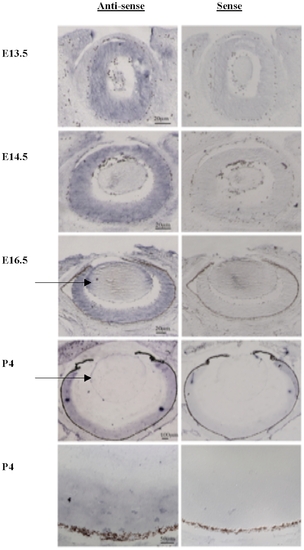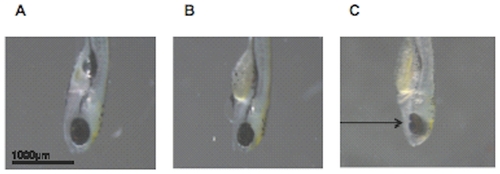- Title
-
A male with unilateral microphthalmia reveals a role for TMX3 in eye development
- Authors
- Chao, R., Nevin, L., Agarwal, P., Riemer, J., Bai, X., Delaney, A., Akana, M., JimenezLopez, N., Bardakjian, T., Schneider, A., Chassaing, N., Schorderet, D.F., FitzPatrick, D., Kwok, P.Y., Ellgaard, L., Gould, D.B., Zhang, Y., Malicki, J., Baier, H., and Slavotinek, A.
- Source
- Full text @ PLoS One
|
In-situ hybridization shows strong expression of TMX3 in the developing murine eye. Fig. 2. In-situ hybridization using antisense and sense riboprobes for TMX3, showing expression in the murine developing eye at E13.5, E14.5, E16.5 and P4. An arrow points to the labeling of the lens epithelium at E16.5 and P4 with the TMX3 antisense probe. |
|
Reduced expression of zgc:110025 results in a small eye phenotype. Fig. 5A. Control injected, wild type zebrafish showing normal eye formation at 6 dpf. Fig. 5B. MO1 morphant zebrafish showing a small eye compared to control at 6 dpf. Fig. 5C. MO1 morphant zebrafish with co-injection of TMX3/(p.Arg39Gln), showing a small ocular coloboma (indicated by arrow) at 6 dpf. Fish are oriented with ventral surface facing left and dorsal surface facing right. PHENOTYPE:
|
|
A comparison of eye size in splice morpholino-injected larvae and control-injected larvae. Graph shows mean eye size (measured in µm on y-axis) for splice morpholino-injected larvae (MO3; light purple) compared to control-injected larvae (Control MO; dark purple) at three different time periods, 2 dpf, 4 dpf and 6 dpf, labeled on the x-axis. Data are shown as mean +/- one standard deviation. A representative single experiment is shown, measuring a minimum of 10-20 independent retinas per data point. Analysis using a Two-sample t-test assuming equal variance showed a significant difference at 2 dpf and 4 dpf (p<0.05 for 2 dpf), but not at 6 dpf (p>0.05). |
|
Islet-1 expression is reduced in morphant larvae compared to control larvae at 2 dpf. Fig. 8A–D. Fig. 8A–B. Labeling of MO1 control-injected zebrafish eye with DAPI (Fig. 8A) and FITC (Fig. 8B) showing labeling for islet-1 at 2 dpf. Fig. 8C–D. Labeling of MO1-injected zebrafish eye with DAPI (Fig. 8C) and FITC (Fig. 8D) showing almost absent labeling for islet-1 at 2 pdf. Fig. 8E–H. Fig. 8E–F. Labeling of MO3 control-injected zebrafish eye with DAPI (Fig. 8E) and FITC (Fig. 8F) showing labeling for islet-1 at 2 pdf. Fig. 8G–H. Labeling of MO3-injected zebrafish eye with DAPI (Fig. 8G) and FITC (Fig. 8H) showing almost absent labeling for islet-1 at 2 pdf, similar to the labeling pattern observed with MO1. Fig. 8I–J. Fig. 8I. MO3-injected zebrafish rescued with human wildtype TMX3 mRNA labeled with DAPI (Fig. 8I) and FITC (Fig. 8J) at 2 dpf, showing labeling with islet-1 antibodies that is similar to labeling in control-injected fish. Ventral is down in all image panels. EXPRESSION / LABELING:
|
|
Morphant larvae show altered formation of the ventral eye. Fig. 9A–D. Fig. 9A–B. Staining of control injected zebrafish eye with DAPI and FITC at 6 dpf to image zpr-1 shows a strong signal that can be seen at the ciliary margins of the retina. Fig. 9C–D. Staining of anti-ATG morphant (MO1) zebrafish eye with DAPI and FITC at 6 dpf to image zpr-1 shows absent signal for zpr-1 at the ventral region of the retina in an eye with a coloboma, whereas staining at the dorsal region of the retina appears normal. Fish are oriented so that the ventral surface of the eye is seen inferiorly in each photograph. EXPRESSION / LABELING:
|
|
Pax2 and Vax2 expression are dysregulated in the region of the choroid fissure in MO1 injected morphant larvae. Fig. 10. Fig. 10A–C. Representative, uninjected (Fig. 10A), control morpholino injected (Fig. 10B) and MO1 morpholino injected (Fig. 10C) whole embryos hybridized with a Pax2 probe. The region of Pax2 labeling at the site of the choroid fissure (indicated by arrows) is enlarged in the MO1 morphant embryo compared to both the uninjected and control-injected embryos. Fig. 10D. Representative control morpholino injected (Fig. 10D–E) and splice morpholino (MO3) injected (Fig. 10E) whole embryos hybridized with a Vax2 probe. The region of Vax2 labeling (indicated by arrows) is enlarged in the MO3 morphant embryo compared to the control-injected embryo. EXPRESSION / LABELING:
|
|
RT-PCR at 2 days post fertilization shows the expected 154 bp band in lane C, containing cDNA from uninjected larvae, and a very faint 154 bp band in lane MO3, containing cDNA from MO3 injected larvae, with probable RNAi mediated decay of the expected mutant 110 bp splice band in the MO3 lane. The primers used are provided in the text of the paper and the 100 base pair (bp) and 200 bp bands from the size marker are indicated. EXPRESSION / LABELING:
|







